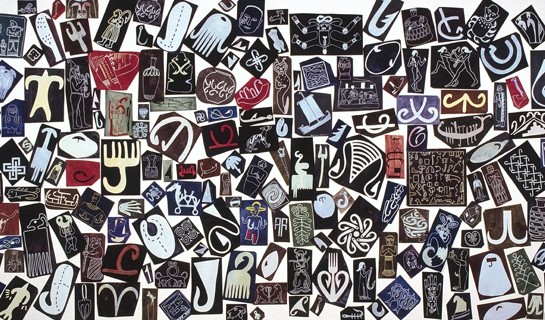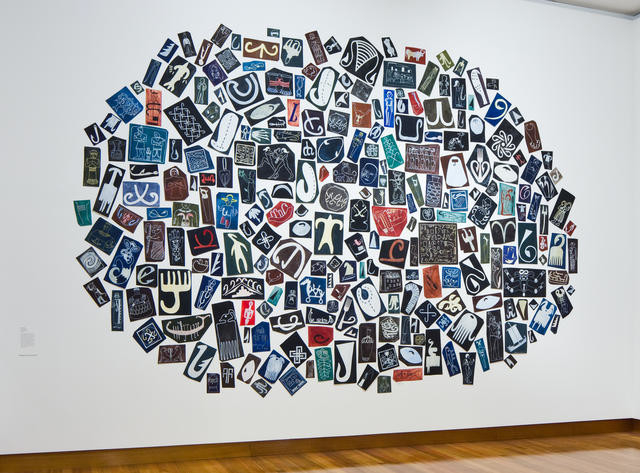Richard Killeen
Aotearoa New Zealand, b.1946
Book of the Hook
- 1996
- Acrylic on aluminium
- Purchased 2000
- 2510 x 6050mm
- 2000/194.1-253
Tags: animals, birds (animals), boats, bulls (animals), combs (hair ornaments), cutlery, families, fish (animals), fishhooks, forks (flatware), horses (animals), knives, moko, pliers, saws, silhouettes, symbols, tattoos, tools
Richard Killeen came to the fore in the 1960s as a painter of oddly stilled and poster-like scenes of sub- urban New Zealand life. He consolidated his growing reputation in the late 1970s when he made the first of his ‘cut-outs’, in which compositional elements were cleanly sliced from pieces of aluminium and allowed to hang in variable arrangements on the gallery wall. For the last two decades Killeen has expanded and deepened the range and possibilities of the ‘cut-out’ format. By the mid-1980s, each individual piece had begun to bustle with images culled from a vast range of sources. In Book of the Hook he concocts a pseudo-museum of anthropological fragments, all 253 of which come from an invented organisation called the ‘Hook Museum’.
Wunderbox (28 November 2008 -15 February 2009)
Exhibition History
In Book of the Hook Richard Killeen has invented a fictitious book of illustrations in the style of an anthropological study, supposedly from the 'Hook Museum'. It is his largest work to date and is comprised of 253 painted aluminium shapes or 'cut outs'. The use of 'cut outs' was first made famous in the mid-1900s by the French artist Henri Matisse (1869 -1954). Book of the Hook is reminiscent of jigsaw puzzle pieces, hieroglyphics, sign writing, rock drawings or ancient symbols. By depicting forms in silhouette, Killeen drains them of their specific individuality and detail, so they exist somewhere between Abstraction and Realism. Born in Auckland, Killeen graduated from the University of Auckland in 1966. He began working as a full-time artist in 1981. He has won a number of awards and has exhibited regularly within New Zealand and internationally, including at the 'Biennale of Sydney' in 1986. Killeen is represented in most major public collections. (Label from before 2006)

